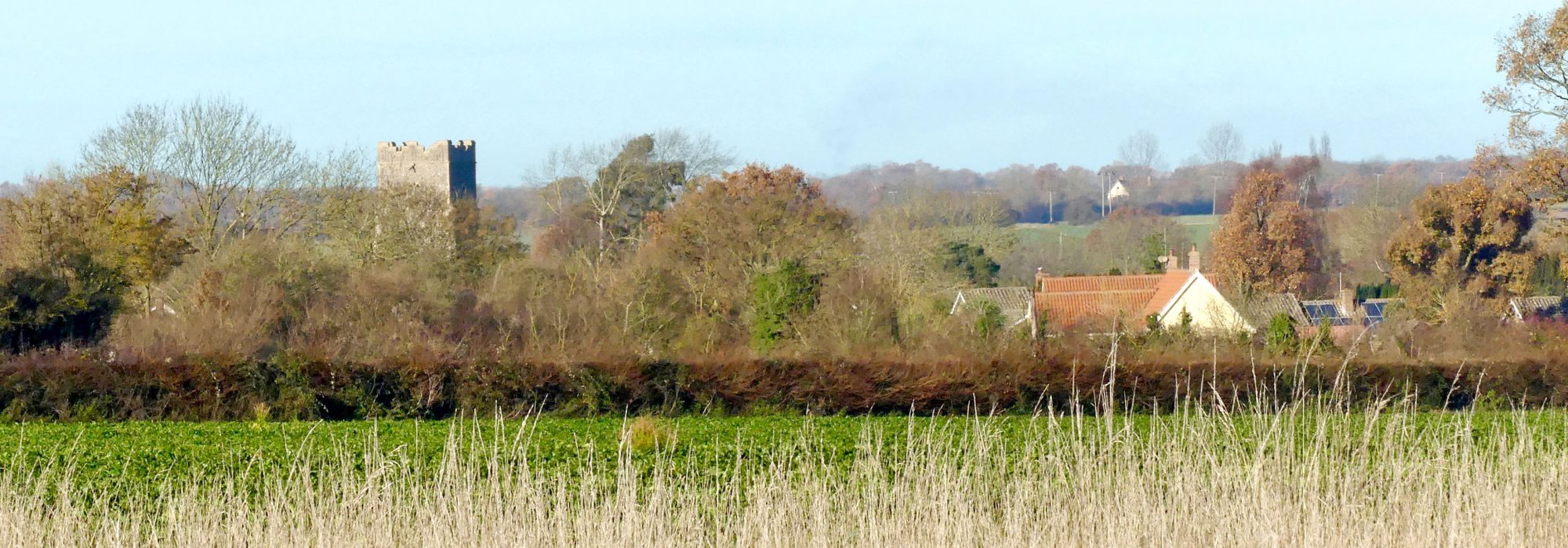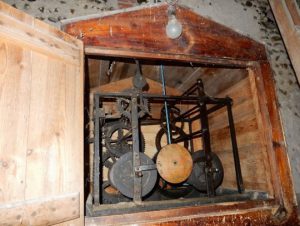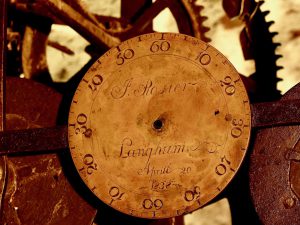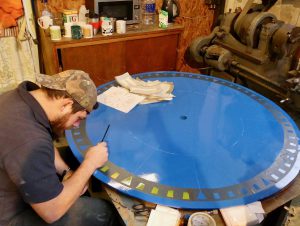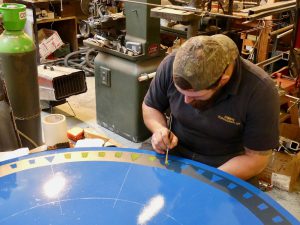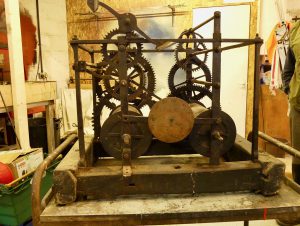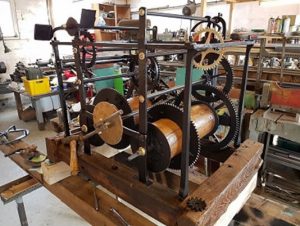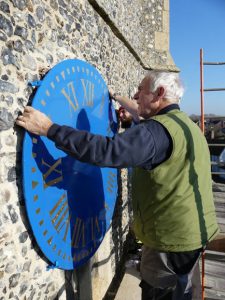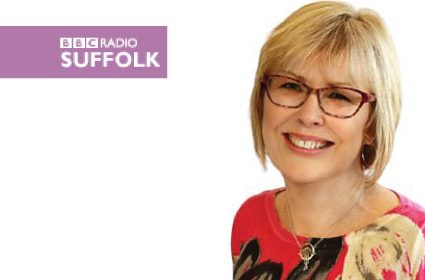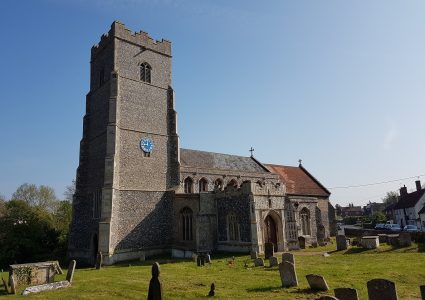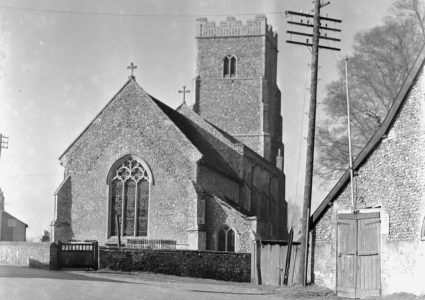The Turret Clock in the tower at St. Mary’s is believed to have been made in the late C17, around 1680. This was either during the reign of Charles II (d.1685) or James II (1685-1688). The tower was built in the late C15 during the reign of Richard III (d. 1485) primarily to house the peel of 5 bells and of course, to “Glorify God”. Turret clocks became popular wherever people needed to gather at specific times for religious services, as in a church or monastery. Originally, turret clocks were set from sundials so clocks in different locations would tell different times, but accuracy was not that important when the pace of travel was dictated by the horse! Although the practical need for turret clocks has virtually vanished, they are very much a part of our cultural heritage especially on church towers.

The oldest recorded clock in England was a water clock at the Abbey in Bury St. Edmunds! It’s recorded that there was a fire at the Abbey in 1198 and the water from the reservoir that served the clock was used to quench the fire!
Clocks, as we know them, first put in an appearance on the continent in the late C13. The oldest known English turret clock is in Salisbury Cathedral which dates from 1386. The oldest turret clock in Suffolk is at Walberswick which dates from 1426.

Photo – A typical turret clock mechanism
Our clock, by comparison, is a mere “youngster” at only 350 years old but nevertheless it is thought to be one of the oldest working clocks in East Anglia.
It has been difficult to date the clock precisely as no receipts exist from the original clockmaker in the C17 who was probably a local blacksmith either working from plans or sketches made from other clocks within the area. The mechanism is quite crude with all the cog wheels being forged and then hand filed. The only piece of evidence the History Society have been able to find is an old bill from 1731 which was discovered in the Suffolk Archive for “Looking after ye clock: 5s-0d”. From this we presume that the clock had been working for a few years beforehand.

Photo – “A bill for ye Church” to the churchwardens from 1731
From the late C17 until 1838 it told the time continuously, but in 1838, it had to be overhauled and updated by a Mr J Rosier of Langham. We know this from an inscription on the clock on the setting dial, the mechanism which was used to adjust the time.
Mr. Rosier was baptised on 29th Nov 1812 in Great Ashfield and died in 1852, aged 40. He was a clock and watchmaker and then, later in life, he became a gunsmith. He married Elizabeth Watson from Langham on 4 February 1834 and they lived in Langham and Walsham le Willows where they had a family of 7 children.
He is described in the 1841 census as a “Gunsmith” and living in Walsham le Willows with Elizabeth, his wife 4 sons and a daughter. There was also a Jeremiah Orams aged 16 living with them and he is described as a Gun Maker’s Apprentice. They also had a servant, Eliza Baker, aged only 12. In March 1842 the family moved to Bedford where he ran a business as a watchmaker and gunsmith. On 1 September 1849 he sold the business and emigrated to Diamond Creek, Victoria, Australia where there was an on-going gold rush. Unfortunately he died only 3 years later from tuberculosis.
As far as we know, the clock then ran continuously from 1838 until late in 2012 when it stopped working completely and couldn’t be re-started.
Whilst the clock had been working throughout the C19 and C20, the striking mechanism stopped working sometime after WW2 and it hadn’t struck the hours for over 50 years. When the PCC starting looking at the clock in 2015, it was found that a part of the mechanism was missing. One of the local people who wound up the clock by hand every 7 days for over 50 years until his death in 1988 was Clears Fordham. After his death, Clears’ ashes were interred in the churchyard at the west end of the church, overlooked by the tower and the clock. In 1976 a new fibreglass clock face had been put on the tower to celebrate the Queen’s Jubilee. This replaced an earlier copper dial.
In October 2012, a report appeared in the East Anglian Daily Times. It provided a comment from the Ipswich Branch of the British Horological Institute who had visited the church on their annual “turret clock tour” around Suffolk.
It stated: “Badwell Ash is an example of a clock (and a church) badly in need of some tender loving care. It (the clock)……..has a birdcage movement in a sadly dilapidated condition, with anchor escapement. The striking train, with its internally cut count wheel, is disabled. The engraving on the setting dial suggests a date of 1838, although it looks older.” The British Horological Journal also commented that “…the little old clock…..is neglected and largely forgotten.”
In 2015, the Parochial Church Council decided that something should be done and they consulted Ian Coote, the Diocesan Clock Adviser, to see whether the clock could be re-started. Ian declared the clock irreparable and said it was in need of a complete overhaul and restoration to make it work again. As a result, the PCC decided to undertake this task and during the early part of 2016, quotations were sought from qualified Horologists to undertake this refurbishment work.
It was decided to appoint Ian Haward of Haward Horological of Felixstowe to undertake the work. Ian’s company has been a family affair as horologists for 5 generations. One of the many clocks they continue to look after is at Fortnum and Mason in London’s West End. Indeed, in 1988, Ian’s father Peter Haward was awarded the ‘Barratt’ Silver Medal, by the British Horological Institute “For his many achievements in horology“.
With financial help from The Heritage Lottery Fund work to completely restore and upgrade the clock was commenced in November 2016. The work consisted of refurbishing the clock face including repainting the hands and numbers in gold leaf, renovating and partially re-building the clock mechanism, the installation of a self-winding mechanism and the introduction of night silencing on the completely rebuilt striking mechanism. The clock now strikes the hours on the 450 year old Tenor bell for the first time in a generation.
Jack Haward painting the restored clock face with gold leaf
On a bright sunny day in December 2016, the restored clock face was put back on the tower ready to receive the refurbished clock mechanism.
We are grateful to The Heritage Lottery Fund for providing financial help to the Parochial Church Council to enable this project to go ahead. Thanks also have to be given to Haward Horological for carrying out the restoration in a seamless way and when problems did arise, they resolved them without fuss or delay. Ian Coote, the Diocesan Clock Adviser was also very helpful in the early stages of this project when consideration was being given as to what to do with the clock and to point the PCC in the right direction towards a complete restoration. Finally, The Badwell Ash History Society should also be thanked for researching the archives for details about the clock and providing a resume of the history of the clock.

